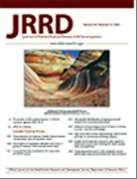Journal of Rehabilitation Research and Development
 | |
Former names | Bulletin of Prosthetics Research, Journal of Rehabilitation R&D |
|---|---|
Abbreviated title (ISO 4) | J. Rehabil. Res. Dev. |
| Discipline | Rehabilitation medicine |
| Language | English |
| Publication details | |
| Publisher | |
Publication history | 1964–present |
| Frequency | 10/year |
| Yes | |
| License | Public domain |
| Indexing | |
| ISSN |
0748-7711 (print) 1938-1352 (web) |
| LCCN | 84646003 |
| CODEN | JRRDEC |
| OCLC no. | 10988482 |
|
Journal of Rehabilitation R&D: | |
| ISSN |
0742-3241 |
|
Bulletin of Prosthetics Research: | |
| ISSN |
0007-506X |
| Links | |
The Journal of Rehabilitation Research and Development is a peer-reviewed open access medical journal published by the Rehabilitation Research and Development Service of the Veterans Health Administration Office of Research and Development. It covers research on rehabilitation medicine. It publishes ten issues in print and electronic formats each year, which can be multi- or single-topic. Recent single-topic issue include traumatic brain injury, dysphagia, cochlear implants, and posttraumatic stress disorder. The journal's website contains the full archive dating back to 1964.
Abstracting and indexing
The journal is abstracted and indexed by:
- Academic OneFile
- Academic Search Premier
- CINAHL
- EMBASE
- Engineering Index
- Science Citation Index Expanded
- Social Sciences Citation Index
- Current Contents/Social & Behavioral Sciences
- Current Contents/Clinical Medicine
- PubMed/MEDLINE/Index Medicus
- Referativny Zhurnal
History
- 1964: The Bulletin of Prosthetics Research, the first in-house Veterans Administration medical journal, published its premiere issue and continued for the next 18 years, through 1982.
- 1983: The Bulletin of Prosthetics Research was expanded into the Journal of Rehabilitation Research and Development, which has been published continuously since 1983. From the first issue, its scope of coverage became more inclusive, including assistive technology (wheelchairs, hearing and reading devices, computers as speech aids), spinal cord injury, prosthetics and orthotics, postsurgical amputation management, and gait restoration.
References
External links
This article is issued from Wikipedia - version of the Wednesday, January 27, 2016. The text is available under the Creative Commons Attribution/Share Alike but additional terms may apply for the media files.